One of North America’s first openly lesbian poets launched her career by pissing off H.P. Lovecraft.
In 1918, at the age of 19, Elsa Gidlow started publishing North America’s first known LGBTQ-themed magazine out of her home in Montreal. Combining queer poetry, one-act plays about young gay love, and progressive social commentary, Les mouches fantastiques quickly gained a cult following far beyond the city and even Canada—culminating in a back-and-forth literary journal spat with the noted horror writer (and racist), who decried the magazine’s promotion of an “ancient selfish hedonism.”
Videos by VICE
In 1920, Gidlow moved to New York City, bringing Les mouches to a close after a five-issue run. Three years later, while living in Manhattan, she published On a Grey Thread, making history once again as the author of what historians believe to be the first openly lesbian poetry book released in North America. By attaching her real name to the work, Gidlow risked the very real possibility of imprisonment on indecency charges—a common tactic the federal government used against other gay writers of the era. Somehow, she evaded repercussions.
Before long, Gidlow made a permanent move to the Bay Area. But it wasn’t until her 50s that she felt she’d finally found a place to call home: In 1954, she established what she called the “unintentional community” of Druid Heights, a collection of idiosyncratic, eco-friendly buildings scattered across 6 acres in Marin County. It was there—holed up in a small cottage up a windy mountain road, living off pesticide-free crops from her garden—that she would complete work on nine more books and live out the rest of her days. One of them was Elsa, I Come with My Songs, regarded as the first autobiography by a lesbian in which the author did not use a pseudonym.
From the 1950s to the mid-70s, Druid Heights attracted a revolving cast of guests and short-term residents that included some of the biggest names in the American cultural avant-garde, from Beat Generation writers like Allen Ginsberg and Gary Snyder, to musicians like Dizzy Gillespie and Steve Miller, to prominent feminist reformers Catharine A. MacKinnon and Margo St. James. For 12 years, it would serve as a hangout spot, and eventually a base of operations, for the influential philosopher Alan Watts, who popularized the practice of Zen Buddhism and the study of Eastern philosophy in the West.

At its height in the late 1960s, the community was home to around 34 people—and to one of the most fascinating chapters in American counterculture and LGBTQ history. Gidlow had plans to turn it into one of America’s first retreats for women artists. That is, until the federal government decided it wanted the land in 1972, setting off a chain of events that would not only threaten the community’s continued existence, but to erase it from collective memory.
In 1977, the National Park Service absorbed Druid Heights into the Muir Woods National Monument, an area of historic redwood trees it had folded into the recently created Golden Gate National Recreation Area (or GGNRA), a sprawling nature preserve on the outskirts of San Francisco that would become one of the most visited national parks in the U.S. After the government invoked eminent domain, only legal tenants were allowed to live there, ending its status as a revolving door for artists and thinkers.
Gidlow stayed at Druid Heights until her death, in 1986. A series of tenants rented out her portion of the property until 2005. Since then, her parcel has sat uninhabited. And though the Park Service has conducted some vegetation removal, rodent protection, and roof replacement on the site as a whole, the federal government has otherwise largely left its fate up to the elements.
Today, what once resembled a bustling small village—replete with a dozen residences, a library, a community center, places of worship, and a water tank—has been reduced to only four habitable buildings. Many of the wildly imaginative structures that once dotted the land are now crumbling, damaged by decades’ worth of water, pests, insects, mold, and trespassers, as documented in 2016 NPS surveys. That same year, a visitor to the property observed that a tree had come close to destroying Gidlow’s house, although the structure remains mostly sound. Gidlow’s personal garden, which she tended long before the concept of “organic” food hit the mainstream, is overgrown with trees and shrubs.
In 2018, The Cultural Landscape Foundation, an historic preservation non-profit, included Druid Heights on its list of U.S. endangered places. Local Park Service representatives told VICE that only four to six full-time residents remain.

The government didn’t reveal that it had ambitions for the site until 2011, when park authorities announced it intended to preserve the district and get it listed on the National Register of Historic Places, an honorific that would attract media exposure, tourism, and potentially funding for its rehabilitation. Druid Heights has been eligible for the Register since 2018; if it gets listed, it will be the first federally designated LGBTQ historic district in the United States. But each passing day brings uncertainty about the site’s survival.
The site’s poor condition is representative of a larger trend in historic preservation. Because of centuries of general anti-gay sentiment and laws punishing queerness, little queer history has been preserved, and much of it has been erased—a fact the Park Service acknowledged in its 2014 LGBTQ Heritage initiative, which identified Druid Heights as a site of significance. “By recovering the voices that have been erased and marginalized, the NPS embarks on an important project to capture and celebrate our multi-vocal past,” the agency stated.
“The apparent federal obfuscation, foot-dragging and practice if not policy of demolition by neglect with regard to Druid Heights is a scandal.” —Gerard Koskovich, LGBTQ historian
But preservationists and LGBTQ advocates who support the rehabilitation of Druid Heights say that the agency has done little to prevent the site from vanishing into oblivion. They get the sense that the NPS doesn’t even want people drawing attention to the place.
“It’s high time for the NPS to take responsibility for preserving this site of national significance for LGBTQ history, women’s history, and bohemian and countercultural history,” LGBTQ historian Gerard Koskovich said. “The apparent federal obfuscation, foot-dragging and practice if not policy of demolition by neglect with regard to Druid Heights is a scandal.”
There’s no singular reason as to why the Park Service hasn’t done more to preserve Druid Heights. The property’s journey through the National Register eligibility process and federal review procedures has been a complicated and protracted affair, exacerbated by concerns over residents’ privacy and a lack of funding. Still, the property’s current dilapidated condition begs the question: Why is the federal government letting the closest thing America has to an LGBTQ historic district fall apart?

Gidlow’s poems were certainly ahead of the times. A stanza from “Constancy,” from On a Grey Thread, reads like a friends-with-benefits arrangement gone wrong:
“You’re jealous if I kiss this girl and that,
You think I should be constant to one mouth?
Little you know of my too quenchless drouth:
My sister, I keep faith with love, not lovers.”
Eventually, Gidlow did choose to be constant to one mouth: that of Isabel Grenfell Quallo, a waitress who had charmed her way into the circles of actors and artists in New York. By then, Gidlow had been living in the Bay Area for nearly two decades, doing freelance writing and dipping into political work. Though they’d missed each other during a trip Gidlow took to the city in 1946, the two began exchanging letters on the insistence of a mutual friend. Eventually, Quallo crossed the country to visit Gidlow—and never left.
“For almost five years, excepting a couple casual encounters, I had not been in love nor made love,” Gidlow wrote in her autobiography. “With Isabel, I felt at once any relationship would not be casual.”
At the time, Gidlow was involved in a bit of a political revolution in her neighborhood of Fairfax, a small town north of San Francisco. Frustrated over a lack of road and street lamp improvements, she and her neighbors formed a taxpayers’ association. After running publicity for a successful campaign to boot several local elected officials out of office, Gidlow eventually joined the town planning commission. The ex-politicians accused Gidlow and her associates of being communists, and in 1947, California’s Un-American Activities Committee subpoenaed her to testify, citing her “radical” poetry as evidence. (Gidlow was more of a “philosophical anarchist.”) While the hearing ended up being a bust, the experience, along with the increasing urbanization of her neighborhood, motivated her to seek a more quiet life, away from prying eyes.
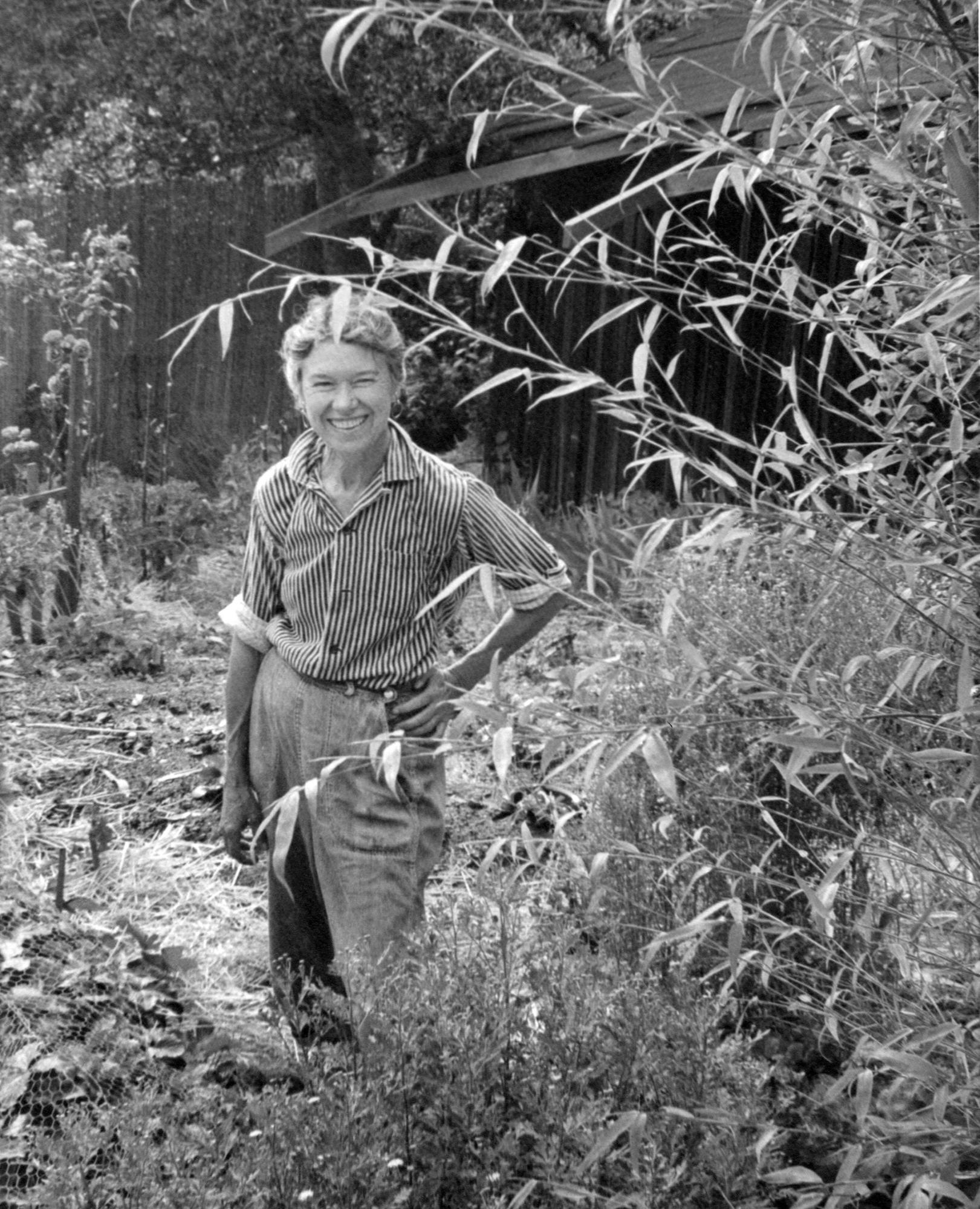
“I knew here was the place to realize a dream that had been germinating for a long time, ever since a child sat beside a brook dreaming it.” —Elsa Gidlow
In 1954, with the help of a loan collateralized by a friend—it was incredibly difficult for “single” women to get credit at the time—Gidlow purchased 5 acres of mountainous forest land in Mill Valley, Marin County, about 15 miles from San Francisco. She moved into the previous owner’s cottage with Quallo and dubbed the property “Druid Heights”: “Druid” was a reference to the ancient Celtic priests—“heights,” to Emily Brontë’s Wuthering Heights.
Despite its remoteness, the land, which eventually expanded to include another acre, was already partially developed. The previous owner had built five structures and lined the property with eucalyptus trees, then 50 feet tall, to help shield it from strong winds. By 1970, the number of buildings had tripled, thanks to the efforts of self-taught architect and jazz musician Roger Somers and his wife, Mary, who had originally shown Gidlow the property; woodworker Ed Stiles, who arrived with his wife in 1965; and other tenants.
By this time, Gidlow was living on her own again. After three years helping Gidlow and Somers tend the property, Quallo had returned to New York in 1957 to care for her daughters—leading the couple to split amicably, after ten years together. Still, Gidlow knew she’d found the sanctuary she’d been searching for.
“Silently I absorbed the stillness, the sunny solitude, the scents from grasses and wildflowers and mingled eucalyptus and bay,” Gidlow wrote in her memoir. “I knew here was the place to realize a dream that had been germinating for a long time, ever since a child sat beside a brook dreaming it.”
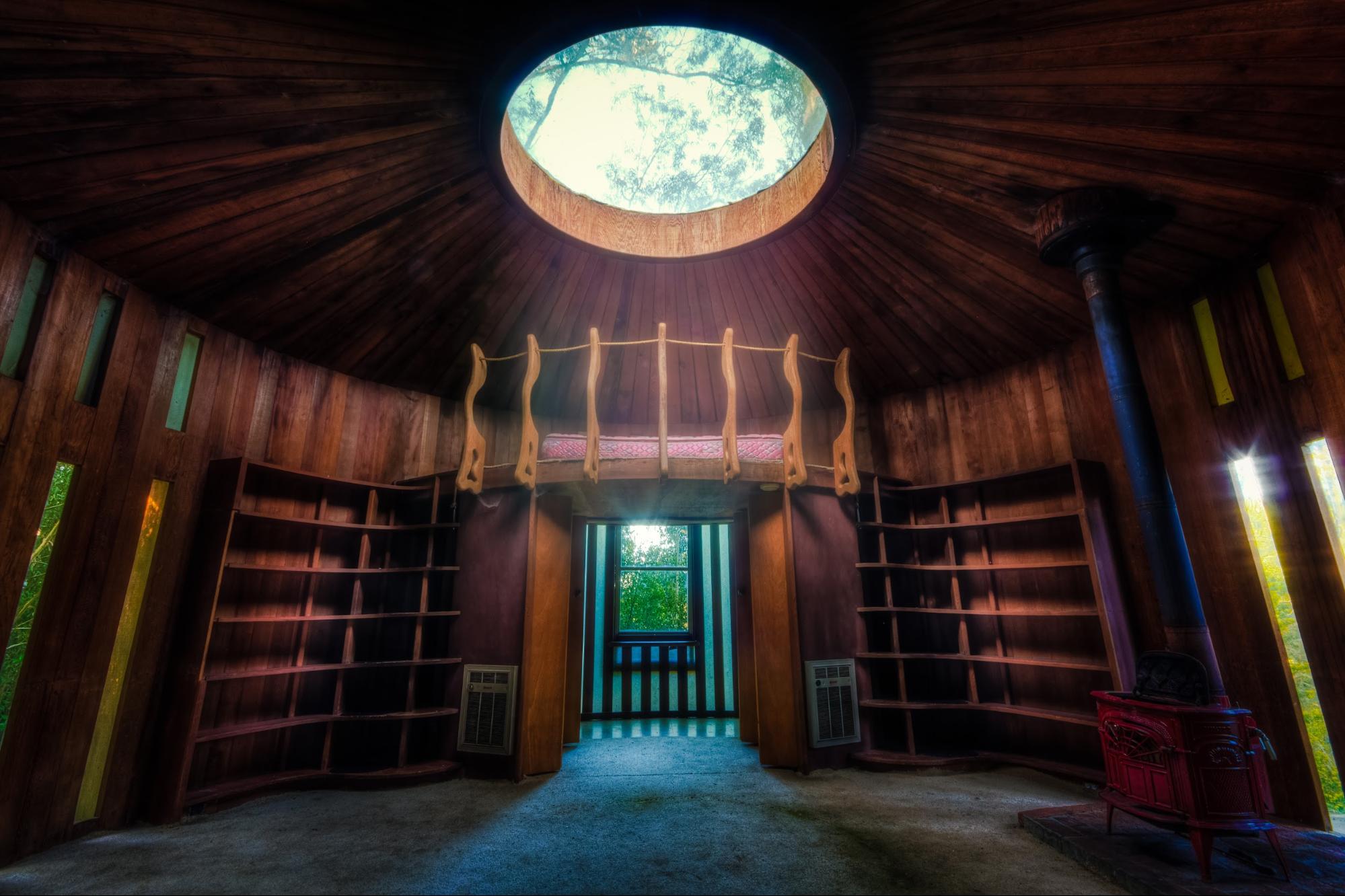
Part of Gidlow’s dream, she later wrote in her autobiography, was “to give courage to others with urges to free themselves for deeper fulfillment than the ossified patterns of establishment culture permits.” The Bed, an experimental short film by queer poet, filmmaker, and regular visitor James Broughton, revealed Druid Heights to be the sort of place where people could freely channel these urges. Shot at the property during the infamous 1967 “Summer of Love,” it features multiple cameos from prominent Druid Heights figures, including a naked Somers playing the saxophone atop a metal headboard.
As a horn player, Somers preferred a free-form style, breaking from the standard tempos and chord changes of cool jazz. He carried this aversion to conformity into his other interests. An avid craftsman, he designed the majority of the buildings at Druid Heights, with help from Stiles; many are made in a DIY style, combining far-flung architectural references with recycled building materials Somers salvaged himself.
The Ranch House, which served as the community’s central hub, had an open floor plan inspired by Frank Lloyd Wright; its living room—known as the Shoji Room, or Zendo—took the form of a Japanese-style temple. There was a building wrapped around two oak trees, which grew through the walls and ceilings, and another, inspired by the shape of a large water tank, that was commissioned as a library for Alan Watts.
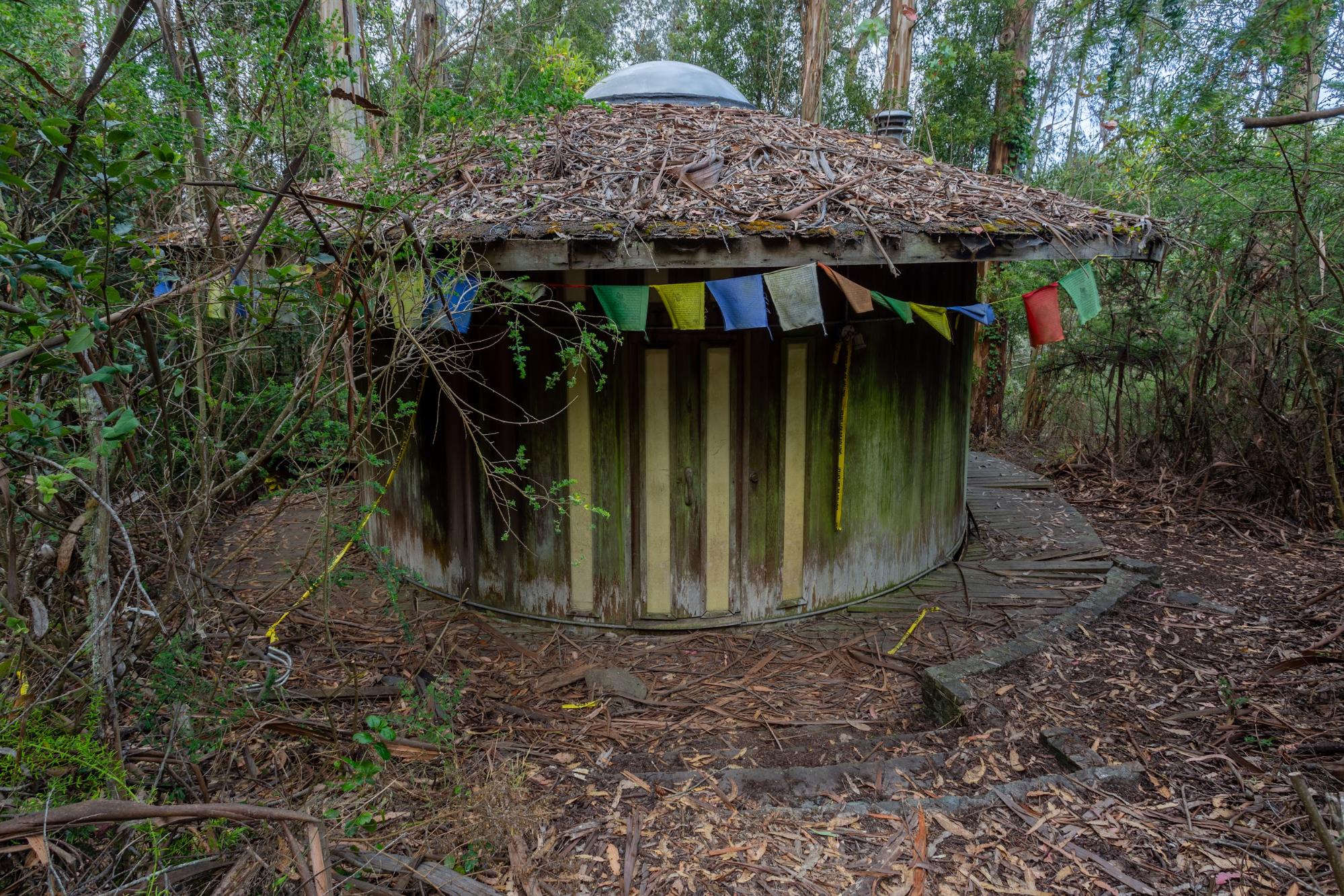
Gidlow had first crossed paths with Watts in San Francisco, where he taught philosophy at the Academy of Asian Studies. In 1962, after Gidlow had relocated to Marin County, they founded the Society for Comparative Philosophy, aimed at providing scholars, spiritual leaders, and other acolytes of Eastern philosophy with the means to conduct research, host lectures, and exchange ideas. While the organization was based out of a ferryboat in Sausalito at first, Watts would frequently make the trip up to Druid Heights to socialize with Gidlow and others. His 1962 book, The Joyous Cosmology, is dedicated to “the People of Druid Heights.” In 1971, he became a full-time resident.
When he first started visiting the community, Watts frequented the Zendo inside the Wright-inspired house, later explaining that he admired the way Somers’ work eschewed the straight lines associated with modern Western architecture: “The world is a ball full of wiggles, and human beings must outgrow the idea of trying to straighten it out,” he proclaimed in his autobiography.
Once the circular redwood library was built in 1972, it became Watts’ official headquarters, and that of the Society for Comparative Philosophy. He wrote and held seminars there, as well as the occasional Japanese tea ceremony. Gidlow noted in her memoir that Watts’ voice “had a quality that captivated most listeners”—especially on acid trips, which had become a ritual of sorts at the community. People from around the world made the pilgrimage to Druid Heights to hear him speak.
“The world is a ball full of wiggles, and human beings must outgrow the idea of trying to straighten it out.” —Alan Watts
Wanting Druid Heights to be “a place for the growth of the spirit,” in addition to her cabbages and camellias, Gidlow often took in young women to mentor. One of her protégés was sex workers’ rights activist Margo St. James, who moved to Druid Heights in 1970. Gidlow’s mentorship inspired St. James to found Call Off Your Old Tired Ethics, or COYOTE, an early organization advocating for the decriminalization of sex work.
Together, Gidlow, Somers, and Watts helped solidify Druid Heights’ reputation as a safe haven for people rejected by mainstream American society. During a time of widespread segregation and racism across the U.S.—and when even other communes in California were predominantly white and heterosexual—Druid Heights openly welcomed people of all races. It counted Quallo, a Black woman, as one of its co-founders, and because of Somers’ jazz connections, famous Black musicians like Dizzy Gillespie and Louis Armstrong would visit or perform there.
Other well-known visitors include rock singer Neil Young, who commissioned Somers to remodel his tour bus in 1975, as well as comedian Lily Tomlin and singer Judy Collins. Feminist legal scholar and sexual harassment law pioneer Catharine A. MacKinnon resided there for a spell in the 80s. In short, Druid Heights was at the forefront of social change in American culture for at least three decades, bringing together some of the greatest minds of the 20th century and influencing the ideas they put out into the world. Then the federal government got involved.
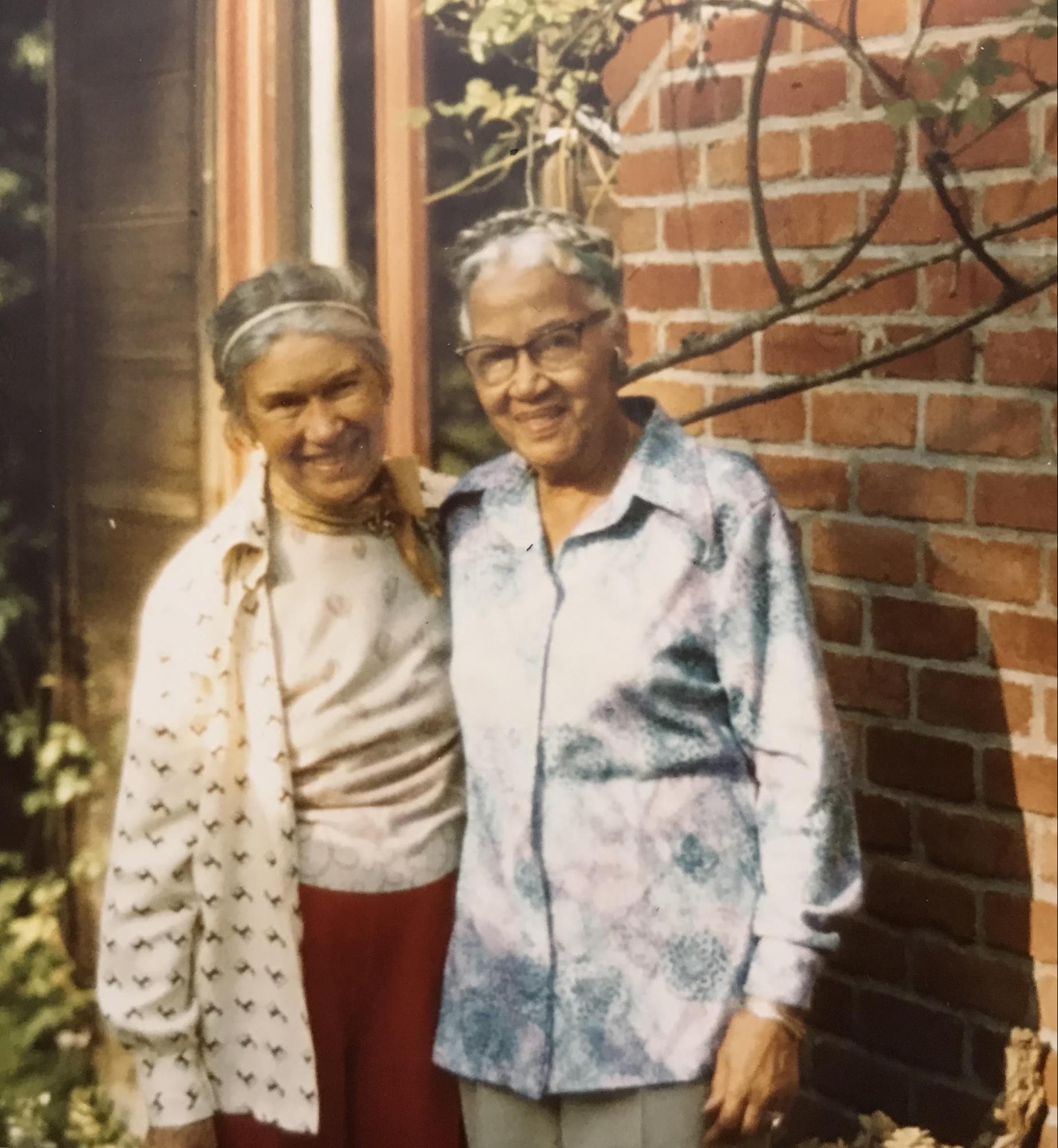
In the late 1960s, real estate developers were eyeing large portions of unused military coastal lands in the Bay Area, while concerned citizens petitioned the government to save the natural spaces. At the same time, the uncertain future of Alcatraz Island, a decommissioned prison off the coast of San Francisco, became a subject of national attention after Indigenous activists occupied the abandoned facility for almost 19 months. Attempting to solve both issues at once, President Nixon signed an act establishing the Golden Gate National Recreation Area in 1972, creating a 34,000-acre region that linked existing parks together and immediately absorbed Alcatraz. Due to Druid Heights’ proximity to the Muir Woods National Monument, the federal government claimed eminent domain, meaning it took ownership of the land for public use, at a price they determined.
By then, Gidlow had deeded her portion of the property to the Society for Comparative Philosophy. (She’d sold half of it to Somers in 1954, and later sold Stiles a portion of what remained in exchange for him building a house for her sister.) Given the group’s religious nature, Gidlow felt its property should be exempt from the government’s efforts. The government disagreed, and offered to pay the society $250,000 for the land—a figure Gidlow called “absurdly low.” She proceeded to launch a legal battle against the government. But facing the possibility of homelessness if she didn’t settle, she came to an agreement with the government in 1977.
The government presented each of the three owners with the choice of a 25-year or life-long lease, to be deducted upfront from their individual payouts. Gidlow, almost 80 at this point, strategically chose the 25-year lease, hoping to maximize the Society for Comparative Philosophy’s time on the land; in exchange, they received just $82,000. Somers and Stiles, who were both much younger than Gidlow, each opted for the life lease.

When Gidlow died, she was buried in her beloved garden. In her autobiography, published a month before her death, she’d revealed the plan she ultimately had in store for Druid Heights. “My vision, my dream, has been taking shape for a long time,” she wrote. “It is of a place where compatible women might be brought together for shared activity on many levels. I have the space here for women artists who can develop a comradeship. I am calling it ‘The Druid Heights Artists’ Retreat.’”
That dream never materialized. Between her death and outstanding legal fees, the Society for Comparative Philosophy fell on hard times; the wild parties and spontaneous poetry readings had already stopped long before, and life at Druid Heights slowed down. Watts had died of heart failure in 1973, with some of his ashes buried next to the library that bears his name. Somers died in 2001, found in his hot tub. Stiles, who did not respond to multiple requests for comment, still lives there, maintaining his portion of the property. Gidlow’s side, and some structures on Somers’ lot, are at risk of being lost forever.
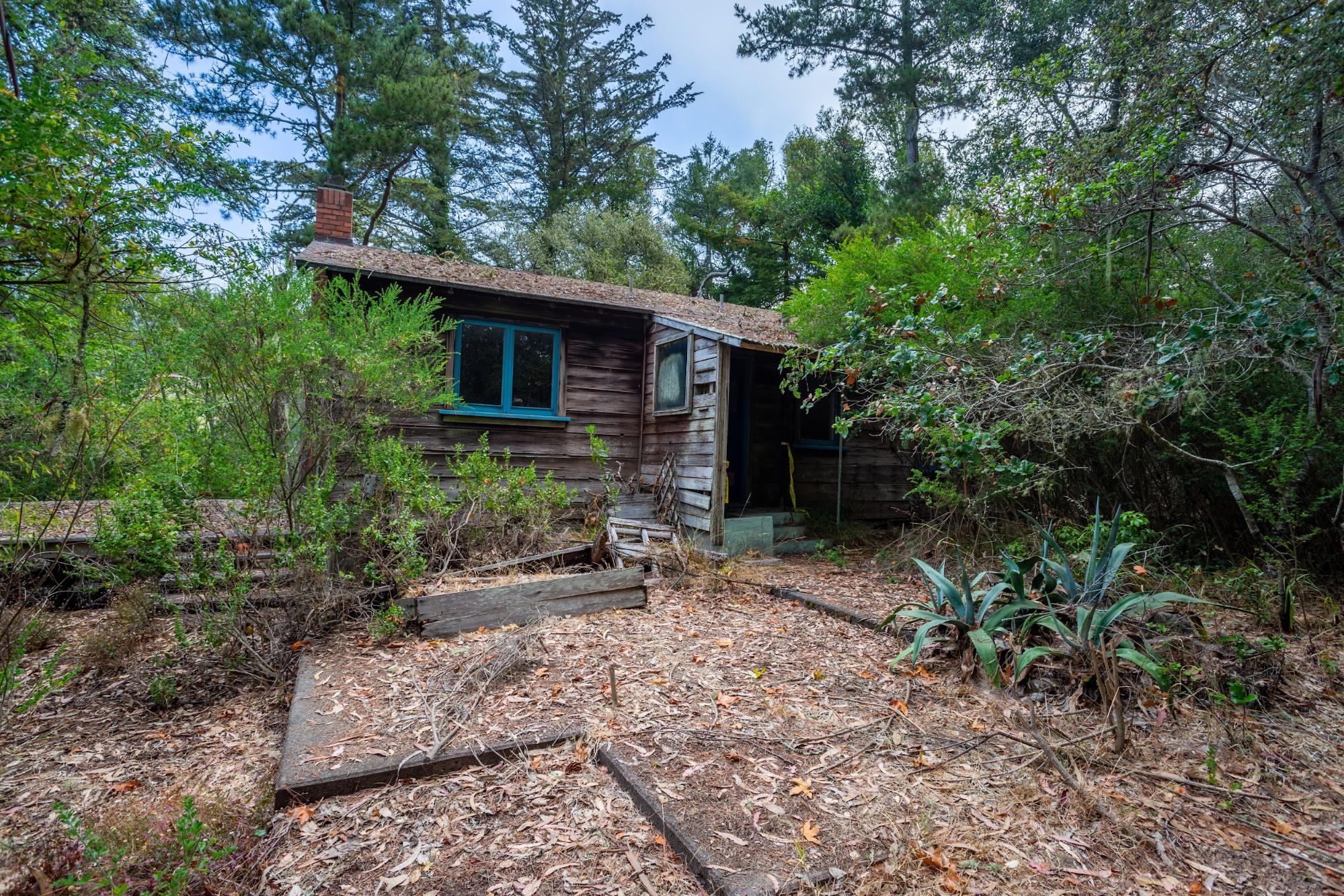
In January 2021, Nikki Silverstein, a reporter for the Pacific Sun, was sitting in her office when she received a strange phone call from an NPS ranger named Mia Monroe. Margo St. James, the pioneering sex workers rights advocate, had passed away a few days before, and Silverstein had messaged Monroe on Nextdoor to inquire about the status of Druid Heights, St. James’ former home. Silverstein had thought of it as a routine assignment. That’s why she was shocked when the ranger called and told her to drop the story.
“She said that it wasn’t news, and that I shouldn’t be writing a story about it,” Silverstein said. “She told me Margaret St. James never lived there. And I found many documents that contradicted that.”
Monroe, who’s been a park ranger since 1978, later admitted to VICE in an email that she’d probably spoken “in haste”; mostly, she said, she’d been concerned that a story about Druid Heights would pose a safety risk, “encourag[ing] visits at a time when safety and privacy for residents was very risky due to COVID.” But her reply made Silverstein curious about the fate of the property.
Though the state of California had formally deemed Druid Heights eligible for the National Register of Historic Places in 2018, Silverstein found that the Park Service was effectively allowing the site to crumble. Under the park’s 2014 management plan, “National Register eligible and listed properties would be monitored on a regular basis to ensure their preservation.” But register inclusion doesn’t legally mandate preservation, and in the article Silverstein ended up publishing in the Pacific Sun, Monroe explained that “protecting the buildings may or may not happen”—even if Druid Heights eventually makes the list.
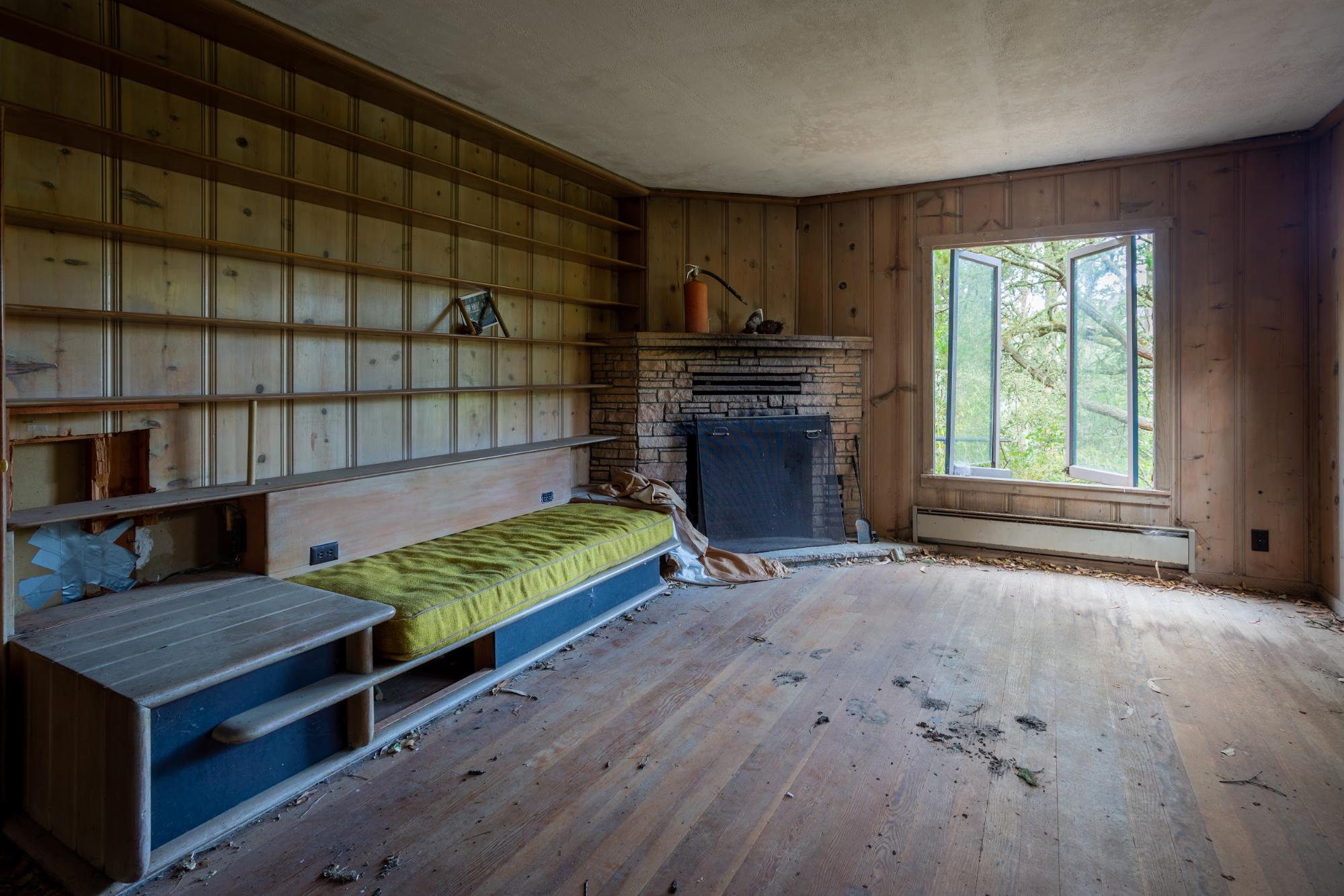
This news devastated those passionate about preserving the space. One of them was Michael Toivonen, a retired woodworker and history buff based in Redwood Valley.
A Marin County native born in 1959, Toivonen said that he’d heard stories about a famous philosopher and elderly poet who lived in the Muir Woods when he was growing up. “I never knew anything about any musicians going there, any rock stars, any unusual architecture—nothing like that,” Toivonen recalled. “It was really off the map.” He was researching Marin County history in 2016 when the name “Druid Heights” popped into his head.
He contacted a high school classmate who lived near the area for directions and set off on a hike. To his disappointment, he discovered an array of dilapidated buildings, unlocked and overgrown with weeds. “I’m just amazed it’s sitting here and being allowed to rot,” he said.
Park Service documents from 2016, the same year as Toivonen’s initial visit, paint a grim picture of the property’s condition at the time. Trees had fallen on the Ranch House. The roof of the library, where Watts once delivered philosophical lectures, was leaking; the walls and ceiling had water damage, the carpeted floors were moldy, and there were signs of a rodent infestation. (For their part, NPS told VICE it “has conducted work at the site” over the years, including annual vegetation removal [and] building protection against rodents.”)
“I’m just amazed it’s sitting here and being allowed to rot.” —Michael Toivonen
In 2017, Toivonen founded the group Save Druid Heights to preserve the once-thriving Bohemian community; its Facebook group has grown to over 1,400 members and counting, and it maintains the most extensive database on Druid Heights history to date. When he first informed Ranger Monroe about the group’s creation, though, Toivonen said he got the sense that the NPS didn’t want people publicizing the property.
In an email to Toivonen, Monroe stressed the tricky balance between preservation efforts and respecting existing residents’ privacy, and claimed that “drawing further attention” to Druid Heights “makes it increasingly difficult for us to do our job.” “I think getting support and connections is helpful but not necessarily what’s needed at this time but appreciate all the legwork you’ve done,” she wrote. (Monroe did not reply to a request for comment on the email.)
Toivonen also noted there are no placards or pamphlets in the park indicating that Druid Heights is a resource there, or even that it exists.
“How can you get the public [to] engage in an often rather wonky process of preserving a place if you don’t really want the public to know much about it?” Toivonen said.
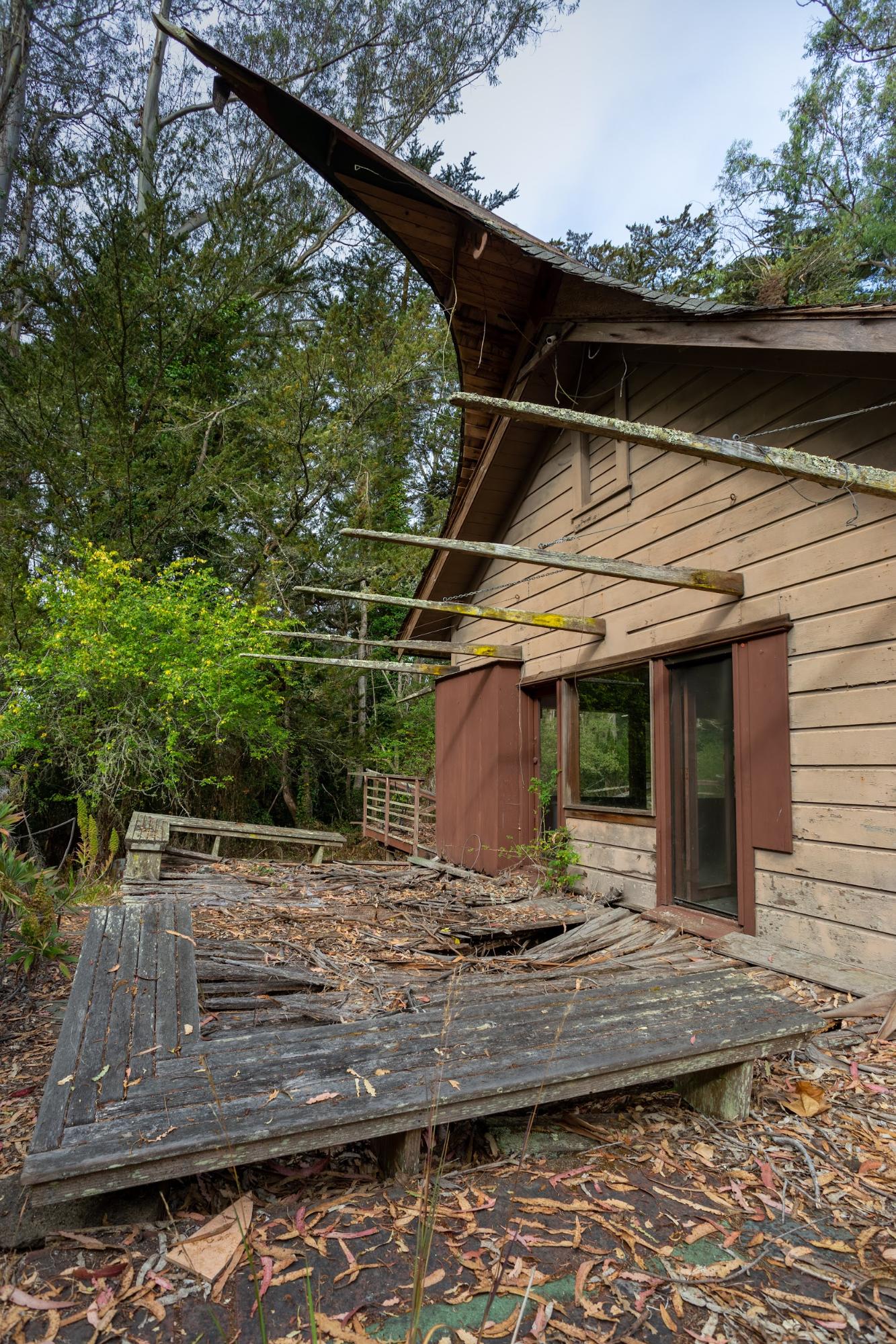
So why isn’t the Park Service taking action on Druid Heights? Officially, NPS says it’s due to lack of money, along with the fact that the historic property is managed as a private residential site and public access is not currently a park planning or funding priority.
“We have to prioritize among hundreds of historic structures, some which are used much more actively, for the funding we are allocated to best serve our agency’s mandates and the millions of visitors we receive each year,” Julian Espinoza, a Public Affairs Specialist for the Golden Gate National Recreation Area, said in an email.
It’s common for the Park Service to delay repairs because of budgetary constraints; officials call this “deferred maintenance,” with the most recent data estimating an $11.9 billion national backlog. In order to decrease the backlog, NPS regularly proposes demolishing assets that have high repair costs and low relevance to the park’s mission. In other cases, where demolition seems less cost-effective, the agency has openly admitted to letting these low-priority assets sit idle and deteriorate.
Park documents obtained through a Freedom of Information Act request show that in 2010, the Service had initially determined that if Druid Heights failed to be eligible for inclusion on the National Register, it would be demolished. Although the Golden Gate National Recreation Area announced in 2011 that it intended to preserve Druid Heights and get it listed on the National Register, the agency indicated that the site’s fate would ultimately depend on its new management plan, a foundational document that dictates how staff should go about running the park for the next 20 years.
“We have to prioritize among hundreds of historic structures, some which are used much more actively, for the funding we are allocated to best serve our agency’s mandates and the millions of visitors we receive each year.” —Julian Espinoza
When the plan finally came out in 2014, it presented a handful of different possibilities for how park staff might approach Druid Heights, regardless of Register eligibility. (Notably, the GGNRA management plan contains no mention of Gidlow, solely attributing Druid Heights’ relevance to Watts.) One option called for demolishing virtually all of Druid Heights to prioritize natural resources; another, which the NPS indicated it preferred, called for the property’s preservation “to the extent practicable,” with limited public access. Although the agency settled on the latter option in January 2015, by all appearances it’s letting the site return to nature.
By the time the 2014 management plan came out, Druid Heights had already undergone a lengthy review process known as Section 106, which requires federal agencies to actively identify and consult with key stakeholders, before reaching any final decision on actions that would affect a historic property.
Stakeholders can include state and tribal governments, members of the public, and historic preservation organizations with a “demonstrated interest in the project.” (For Druid Heights, stakeholders also include past and present residents, along with their descendants.) The process is meant to be “an important tool for citizens to lend their voice in protecting and maintaining historic properties in their communities,” a government advisory council notes on its website, adding that “agencies must give the public a chance to learn about the project and provide their views.”
In 2018, when Toivonen relayed his frustrations over the Park Service’s inaction toward Druid Heights to the GGNRA’s cultural resources director, the director suggested that key stakeholders in the project were all aligned with the Park Service’s approach and that Toivonen was alone in his dissatisfaction. “I know of no other Druid Heights stakeholders or residents that feel this way,” director Gordon White said in an email. “We have been in contact with all and have general agreement on our approach.” (White did not respond to multiple requests for comment).
However, when coming to a decision on the future of Druid Heights, it is unclear whether the agency ever meaningfully consulted with organizations from the public, who could have fought for more preservation work.
There is one organization that seems like it would have been an obvious contender: the San Francisco-based GLBT Historical Society, an internationally-recognized leader in the LGBTQ public history field for more than three decades that has housed Gidlow’s personal archive since 1991.
But six people associated with the Historical Society did not recall the Park Service ever involving the organization in planning efforts, including founding member and noted LGBTQ historian Gerard Koskovich. “It’s clear the GLBT Historical Society should have been considered a major community stakeholder with regard to planning around Druid Heights,” Koskovich said. “And should now be given that status, if belatedly.” NPS told VICE in an email that staff spoke to individual members of the GLBTHS during their Register eligibility research, and that “all of the advocacy groups currently involved in the public media inquiries have received all of the information available and individual correspondence about any updates.”
Taken together, the agency’s lack of transparency with the public throughout the process and the property’s deteriorating state has led preservationists to believe the park’s “deferred maintenance” of Druid Heights amounts to “demolition by neglect,” as Koskovich put it: knowingly letting a historic site deteriorate, sometimes beyond the point of repair.

There are clear financial reasons why the NPS might delay a determination on Druid Heights’ future. The longer the agency ignores the place, the more likely it is that the structures will fall apart naturally, ultimately saving the agency preservation and demolition costs.
But if money were the only issue, the NPS could recruit an outside group to put up the funds. The agency has put out proposal requests to rehabilitate the park’s historic military structures in the past, and its non-profit partner, the Golden Gate National Parks Conservancy, has a long track record of drawing attention and funneling funds to park areas in need. But the most it has done for Druid Heights to date is a series of invite-only walking tours, in 2011. (When VICE reached out, the Conservancy redirected questions to NPS, which declined to comment on this matter.)
So what’s the hold-up? Toivonen said the agency may ultimately be deferring to the last remaining Druid Heights founder, Ed Stiles, who still lives among the buildings he helped construct. In a 2013 article about Druid Heights’ future, Marin Magazine noted, without explanation, that he was “not particularly anxious that its story be told.” And when Toivonen first formed Save Druid Heights in 2017, he received an email from Stiles and his wife expressing that they wanted to see Druid Heights eventually “go back to nature.”
Whether the remaining residents have legal standing to dictate what happens on Gidlow’s side is unclear. They may also get a say on the fate of Gidlow’s lot as neighbors, since maintenance work would bring more people and noise to the area. Toivonen points out that the properties are spaced out, which could make it easier to avoid intrusion, though he firmly believes in respecting residents’ privacy and understands the concern.
Whatever the case may be, why exactly the Park Service is quietly allowing Gidlow’s lot to deteriorate, with no clear indication of when it will move ahead with repairs, remains a mystery, especially given that NPS has specifically pledged to preserve and share the stories of LGBTQ Americans.
“Studies show that when positive portrayal of populations (including LGBTQ, African Americans, Asian Americans, and Latinos) are excluded from popular narratives […], members of those groups suffer lower self-esteem,” NPS says on its website. “Seeing oneself as part of the story, as part of history, is important to feeling part of a society.”
Out of the thousands of historic sites the federal government owns, only a handful have been specifically recognized for their role in LGBTQ history. None of the federally owned historic sites have been officially designated as an LGBTQ historic district, and Druid Heights would be the first. While the privacy concerns add an extra layer of complexity, the Park Service’s inaction is ultimately contributing to the very same erasure the agency says it is committed to fighting.
“We are very sympathetic to the concerns of advocacy groups focused on this area, and disagree with their assertions about our lack of planning and management for the site,” a spokesperson for the GGNRA told VICE in an email. The spokesperson stressed that the Druid Heights historic area had “received significant attention” by park staff over the years, including checking in with residents on a monthly or weekly basis, conducting routine maintenance, and “planning as funding becomes available.”
“We do what we can to be stewards of these places and stories, with the funding and staff we have,” they concluded. “We continue to protect Druid Heights and balance its needs with those of the other important cultural resources in our park.”
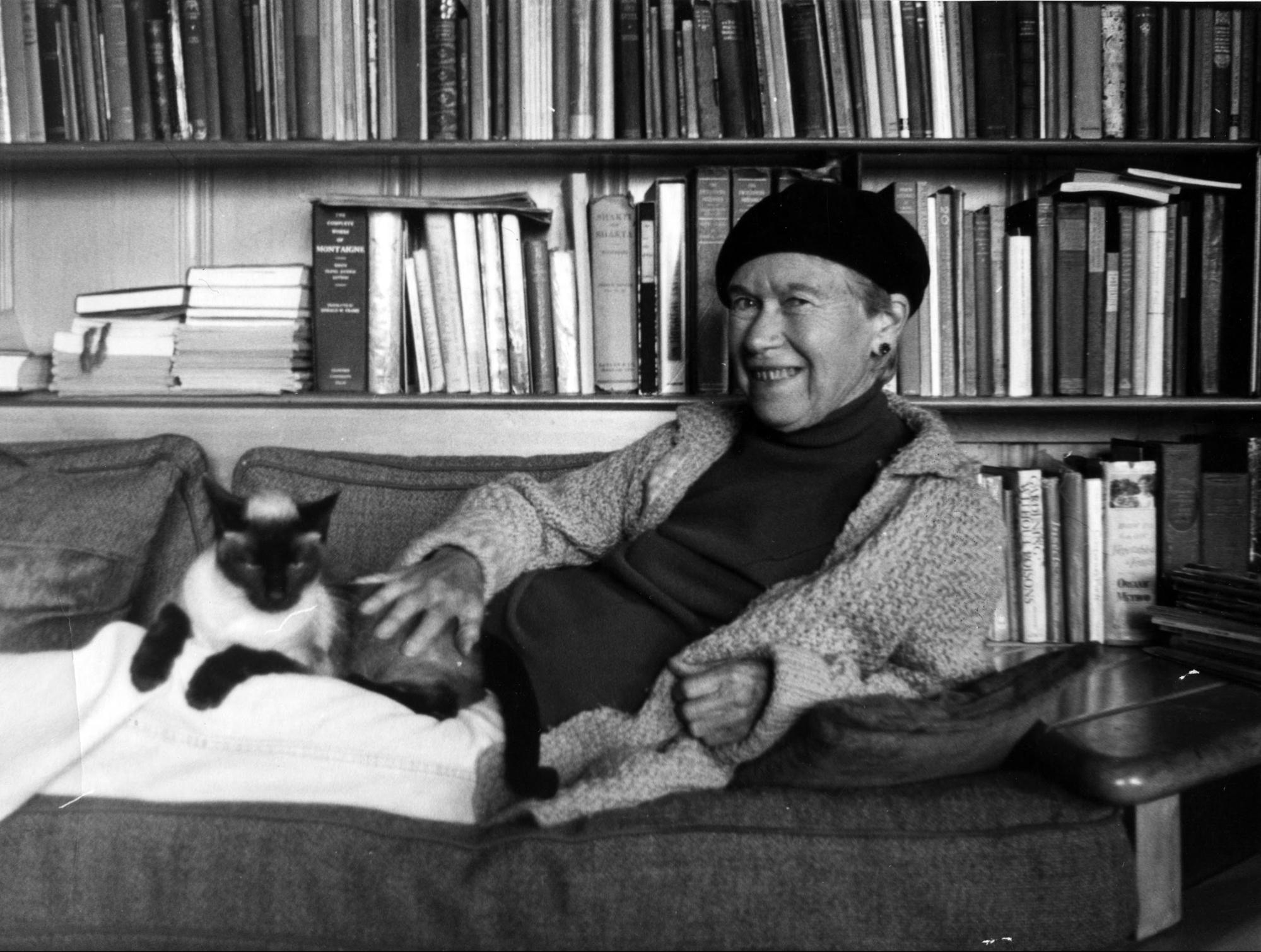
Should the Park Service finally decide to invest in Druid Heights, Toivonen said he has hope that Gidlow’s vision for an artists’ retreat could one day become a reality. In his opinion as a professional woodworker, it’s not too late for repairs—though he doesn’t know for how much longer that will be the case.
There are reasons why Gidlow’s dream would be hard to pull off. The Park Service’s plan says it will convert the only entry road serving Druid Heights into a trail accessible only by foot or light service vehicles—making it harder for maintenance crews and emergency vehicles to access the site. And even if workers found a way to bring equipment to the property, NPS lacks detailed architectural drawings that could serve as a reference for preservation work.
Still, with enough money and willpower, rehabilitating the property wouldn’t be entirely unprecedented. Beginning in 2007, the Cape Cod Modern House Trust went up against the Park Service to preserve a community of similarly deteriorating modern architecture houses, once home to world-renowned architect Marcel Breuer and The New Yorker artist Saul Steinberg. It has since rehabilitated four of them for artist and scholar residencies.
Alan Watts’ son, Mark, is in the midst of launching a similar restoration project for Druid Heights. Though it’s only for his father’s library so far, he told VICE that he hopes to eventually expand to other buildings on the property. While he’s been hoping to get the project off the ground for years, he said that the Park Service has recently been receptive, and that he’d rather focus on the task at hand. “Your time is now,” Mark said to anyone hoping to get involved with saving the property.

And when it comes to the complicated politics of identity, community, and preservation, there are signs that things are changing. For the first time in the country’s history, the Department of the Interior, overseer of NPS, is led by a Native American, Deb Haaland, who’s pledged to fight for marginalized communities. And in the past decade that Druid Heights has stood weathering the elements, queer people have made significant strides in achieving equal rights and cultural acceptance. When NPS released its Golden Gate National Recreation Area management plan in 2014, same-sex marriage was still illegal in 15 states, and 3.7 percent of Americans identified as LGBT, according to Gallup polling. Today, 5.6 percent of Americans identify as LGBT, and same-sex couples are tying the knot everywhere in the country.
Still, the 2010s saw the Pulse nightclub shooting, the deadliest act of violence against LGBTQ people in American history, as well as the continued decline of queer gathering spaces. As of July of this year, there were only about 21 lesbian bars left in the country, and just this past Pride month, landlords threatened to put a storefront that used to be a part of the original Stonewall Inn, birthplace of the modern-day LGBTQ rights movement, back on the market. While President Obama designated the site as a national monument in 2016, giving NPS ownership of the small park across the street, the building itself remains privately owned.
LGBTQ people continue to face difficulties accessing, establishing, and maintaining safe spaces. They’re struggles that were all too familiar for Elsa Gidlow: She spent her life creating spaces for herself and those like her, be it in a redwood forest, or in the pages of a magazine. In the closing pages of her memoir, she expresses her dying wish for Druid Heights: That it might provide visitors a few moments of respite from an often hostile world.
“I have no illusion that The Druid Heights Artists’ Retreat can do much to redress the wrongs of ages,” she wrote. “But if it can provide respites of leisure and tranquility to even a few gifted women to give unhampered of their best, the hope I have for it will be realized.”
Correction: This story originally stated that feminist legal scholar and sexual harassment law pioneer Catharine A. MacKinnon resided at Druid Heights in the 70s. She resided there in the 80s. We regret the error.
More
From VICE
-

Photo: Gremlin / Getty Images -

Photo: Antoine Rouleau / Getty Images -

Photo: Cabezonication / Getty Images -

Photo: peepo / Getty Images
